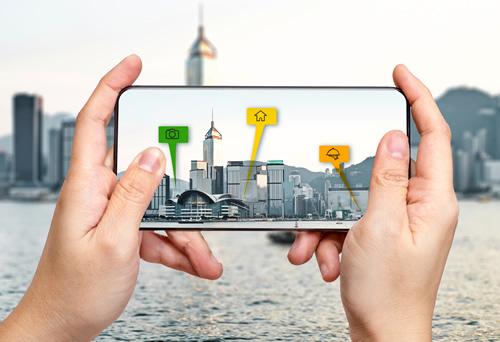Augmented reality has been one of higher ed’s big buzzwords for a number of years, but it’s not until just fairly recently that institutions have used the technology in practical ways. Now, higher-ed augmented reality apps are having a moment that extends past the novelty of Pokemon Go–and K-12 could take some of those lessons into its own classrooms.
Most augmented reality apps address a variety of things, such as bringing science concepts to life, improving student retention, and offering campus tours or glimpses of historical moments on campus.
Read more: 5 ways to use AR and VR in the classroom
Here’s how five institutions have harnessed augmented reality apps to address campus needs and take learning to the next level–these methods could inspire early K-12 adopters to look into ways they can use augmented reality apps in similar ways.
5 institutions using augmented reality apps in unique ways
1. Researchers in Penn State University’s Department of Geography created an augmented reality app to give users more background about one of the oldest and best-known monuments on the school’s University Park campus. The Obelisk was constructed in 1896 from regional rocks and minerals, and its 281 stones are arranged in order by geologic time period. “There’s a database connected to each stone, so whenever you touch any stone in the app, you can see where it came from, how old it is, and other information,” says Arif Masrur, doctoral student in geography. “Eventually our goal is to also include 360-degree photos of the actual environment from where each rock was excavated.”
2. Cal Poly Pomona uses augmented reality in its Pokemon Go AR library orientation and scavenger hunt. The “orientation” lets students, through use of the Aurasma app on their own devices or with a device borrowed from the library, walk through the library and find videos about varying services and the basics of finding information.
3. SUNY Orange is using AR to implement a student recruitment campaign. Imagination Park will enable SUNY Orange students to point their phones at logos, signs, posters, and landmarks on and around campus to view or retrieve school news, updates, retailer coupons, messages, videos and more. The app presents students with a new world of interactive entertainment options while at SUNY Orange campuses in Middletown and Newburgh, New York. “We plan on using AR in conjunction with our students’ return to campus in August in order to enhance their SUNY Orange experience,” says Vinnie Cazzetta, SUNY Orange’s vice president for institutional advancement. “We host a series of events that welcome new and returning students alike back to our campuses. In conjunction with those events, and throughout the semester, we’ll use augmented reality to help direct students to those support services that are so critical to their academic success.”
Related: Check out these 10 AR apps for your classroom
4. Students of the Creative Media and Digital Culture program at Washington State University Vancouver created an AR app to engage visitors with the history and story of a local boarding school and orphanage. The app offers insight into the nuns who worked there and the students who attended Providence Academy in downtown Vancouver, WA. Students also developed an interactive website with a digital timeline that further showcases the accolades of Mother Joseph and accompanies the content of the application.
5. The cARdiac ECG AR app is an engaging and practical way to start learning about the ECG and heart fundamentals through augmented reality. Developed by Deakin University’s School of Medicine and Eon Reality, the app leads users on an interactive journey to explore the fundamental concepts of cardiac anatomy, physiology, and pathophysiology relevant to the ECG.
- Friday 5: Virtual field trips - April 26, 2024
- Google, MIT RAISE launch no-cost AI training course for teachers - April 26, 2024
- 4 ways to support work-based learning - April 23, 2024

